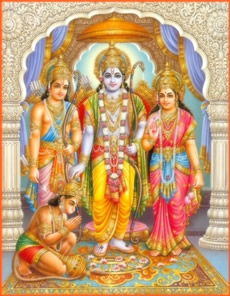 |
| Ramayana |
It is shorter than the Mahabharata (Great Bharata dynasty), the other great epic poem of India. Some of the followers of the Ramayana date its origin to 880,000 b.c.e. While its exact origins are lost in Indian antiquity, the Ramayana is today attributed to the poet Valmiki. Most scholars believe that it was written in the third century b.c.e.
The Ramayana has been redacted several times, leading to several versions. These are divided into five, six, or seven books. The Ramayana contains 24,000 couplets. The verses are called sloka (two-line verses, each of 16 syllables), in Sanskrit.
They have a complex meter called anustup. The verses are grouped into individual chapters called sargas, which are grouped into books called kandas. The name kanda is taken from the internode stem of sugarcane. It suggests that each phase of the story is connected to the next phase.
  |
The Srimad Valmiki Ramayana version is arranged into six books. The first book is the Bala Kanda (Book of youth, 77 chapters). The second book is the Ayodhya Kanda (Book of Ayodhya, 119 chapters). The third book is the Aranya Kanda (Book of the forest, 75 chapters).
The fourth book is the Kishkindha Kanda (Book of the empire of holy monkeys, 67 chapters). The fifth book is the Sundara Kanda (Book of beauty, 68 chapters). The sixth book is the Yuddha Kanda (Book of war, 131 chapters). The Ramayana is included in the great collection of Hindu books that were remembered, or smriti.
These are different from the shurti, which are books that were heard. Books in the shurti category include the Vedas. The Ramayana is known also as the Adi Kavya, which means the "original poem", and is certainly one of the oldest, if not the first, epic poem produced in India.
The Ramayana tells the story of the history of Rama, who was a king from a line descending from the sun god Surya. With his wife, Sita, he ruled an earthly kingdom. In some versions the beginning is the birth of Rama in the kingdom of Ayodhya; in others the beginning is Rama’s wooing of Sita, daughter of King Janaka.
He wins her hand by being the only suitor able to bend the mighty bow of Siva (Shiva) at a bridegroom tournament. In yet other versions the Ramayana begins when Prince Rama is chosen as the heir of his father, King Dasartha of Ayodha.
However, King Dasartha’s wife, Kaikeyi, pleads for the appointing of another son, Bharata, to be made king instead. King Dasaratha reluctantly agrees, and Rama is exiled from his kingdom. He goes into the forest for 14 years with his beautiful wife, Sita, and his half brother Laksmana.
In the forest Rama meets the demoness Surpanakha, who falls in love with him. He refuses her advances while Laksmana wounds her. She flees to the island kingdom of Lanka, where her brother, also a demon (raksasa), Ravana rules.
Surpanakha tells Ravana of the beauty of Sita. Desiring Sita for himself, Ravana decides to take her. He disguises himself as a holy man and finds her in the forest. He kidnaps Sita and carries her off to his palace at Lanka.
He tries to have his way with her, but she refuses and remains loyal to Rama. Grief stricken, Sita mourns in Ravana’s garden, as Rama and Laksmana search for her. Eventually, they meet Surgriva, the monkey king, who agrees to help.
The monkey general Hanuman searches for Sita. He finds Sita and shows her Rama’s ring to prove that he is Rama’s messenger. However, Ravana catches Hanuman and sets his tail on fire. In the excitement the monkey escapes and sets fire to the island of Lanka.
Rama and Laksmana attack Lanka, aided by the monkey army led by Hanuman. After a long siege Rama kills Ravana and regains Sita. However, Rama makes Sita prove her virtue by putting her to a test of fire.
She undergoes the test successfully, proving her chastity. Rama, however, later abandons her after public opinion will not accept her. She goes to the ashram of the sage Valmiki, to whom she tells her story. There she bears twin sons—Lava and Kusa.
When they are grown they are united with their father, Rama. Rama and Sita are often pictured as the ideal couple for their devotion to charma in the quest for victory over evil. The Ramayana greatly influenced Indian poetry, establishing the sloka meter that developed in later Sanskrit poetry.